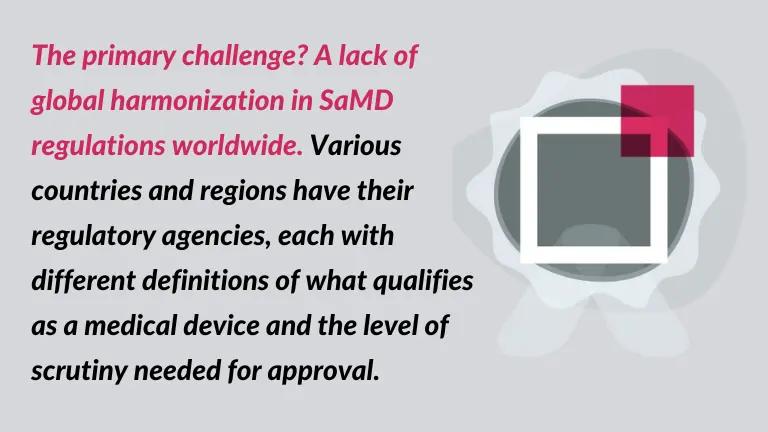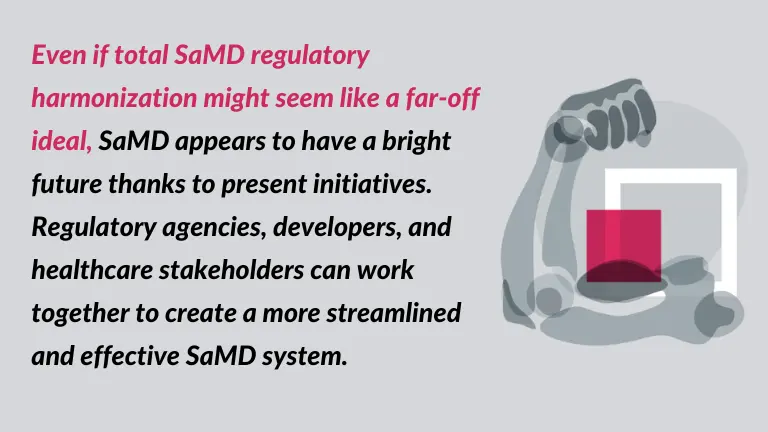Untangling the web: why harmonization is key for SaMD regulatory
We have written multiple times that there is a revolution currently happening in the field of medicine and also in the SaMD regulatory field. Software as a Medical Device (SaMD) rapidly changes healthcare by offering various tools, including AI-powered diagnostics and mobile apps for managing chronic diseases.
However, developers of these innovative solutions often encounter difficulties navigating the complicated regulatory environment. [1]
The maze of SaMD regulatory: a hurdle for innovation
The primary challenge? A lack of global harmonization in SaMD regulations worldwide. Various countries and regions have their regulatory agencies, each with different definitions of what qualifies as a medical device and the level of scrutiny needed for approval. This results in a scenario where software that easily gets approved in one region may encounter significant obstacles in another.
Consider a groundbreaking diabetes management app that goes through a seamless approval process in the US, only to encounter regulatory hurdles in Europe due to differing classifications or clinical trial requirements. This fragmented system not only impedes innovation but also prolongs the accessibility of potentially life-saving tools for patients across the globe.
Let’s discuss another example. Think about this scenario: a developer creates a novel Software as a Medical Device (SaMD) application that has the potential to transform a particular medical condition. However, the developer would have to negotiate a complicated web of rules before this innovative treatment could be made available to patients everywhere. This could include obtaining individual approvals for each market in which the product is intended. This causes innovators to face heavy financial and administrative difficulties in addition to delaying access to potentially life-saving innovations.

Steps towards effective harmonization in Software as a Medical Device regulations
To tackle these obstacles, a multifaceted strategy is necessary:
- International cooperation to harmonize regulatory approaches. Regulatory organizations need to promote information sharing and best practices through platforms such as the International Medical Device Regulators Forum.
- Adaptive regulatory frameworks where it’s critical to create adaptable, risk-based regulatory frameworks that keep up with technology developments. This flexibility can be aided by regulatory sandboxes, which allow developers to test innovations under regulatory oversight.
- Stakeholder engagement which means that involving all relevant parties, such as patients, healthcare providers, and industry representatives, guarantees that harmonized regulations are thorough and meet practical demands.
Benefits of unification in regulations
SaMD regulatory harmonisation represents a future where a single, clear set of regulations governs these innovative tools on a global scale. This would offer a multitude of benefits.
Firstly, reduced costs and faster time to market. Streamlined regulations would significantly reduce the time and resources needed for developers to obtain approvals, allowing them to bring their products to market faster and at a lower cost. This would unlock greater investment in SaMD development and accelerate innovation.
Secondly, a global stage for innovation. Regulatory clarity fosters a more fertile ground for innovation. Developers would be free to focus on creating groundbreaking solutions without being bogged down by the complexities of navigating diverse regulatory landscapes. This would lead to a surge in SaMD development, pushing the boundaries of what’s possible in healthcare technology.
Thirdly, improved patient access: harmonisation would expedite access to cutting-edge SaMD technologies for patients worldwide. This could significantly improve health outcomes for individuals regardless of their geographic location, promoting greater equity in healthcare.
And fourthly enhanced Patient Safety: Consistent safety standards across regions would ensure a high level of patient protection regardless of where they receive care. This would build trust in SaMD technologies and encourage wider adoption. [2]

Key organizations and regulatory frameworks
Regulatory unification is not simply empty rhetoric. Various international organizations and regulatory bodies play a crucial role in driving harmonization efforts in the SaMD field.
- The International Medical Device Regulators Forum (IMDRF) works on the development of standardized principles and criteria for SaMD. It has been made possible in part by the IMDRF. As part of their work, important documents like “SaMD: Key Definitions” and “SaMD: Clinical Evaluation” were created. [3]
- U.S. Food and Drug Administration (FDA). The FDA has created a regulatory framework for digital health that includes rules tailored to SaMD and places a strong emphasis on a risk-based approach to regulation. [4]
- European Medicines Agency (EMA) and Medical Device Coordination Group (MDCG). These organizations offer regulatory frameworks and recommendations for SaMD in Europe with an emphasis on assuring product efficacy and patient safety. [5], [6]
- International Organization for Standardization (ISO). A lot of countries have accepted ISO standards, such as ISO 13485 for medical device quality management systems, as the foundation for their regulatory needs. [7]
Conclusion: a collaborative effort
Even if total SaMD regulatory harmonization might seem like a far-off ideal, SaMD appears to have a bright future thanks to present initiatives. Regulatory agencies, developers, and healthcare stakeholders can work together to create a more streamlined and effective SaMD system. Thus, SaMD’s full potential will be unlocked, enabling medical professionals to better serve patients globally in the process.
Resources:
[1] International Medical Device Regulators Forum (IMDRF). Software as a Medical Device (SaMD): Key Definitions, https://www.imdrf.org/sites/default/files/docs/imdrf/final/technical/imdrf-tech-131209-samd-key-definitions-140901.pdf
[2] WHO Global Model Regulatory Framework for Medical Devices including in vitro diagnostic medical devices, https://www.who.int/publications/i/item/9789241512350
[3] International Medical Device Regulators Forum, https://www.imdrf.org/
[4] FDA, https://www.fda.gov/
[5] European Medicines Agency (EMA), https://www.ema.europa.eu/en/homepage
[6] Medical Device Coordination Group (MDCG), https://health.ec.europa.eu/medical-devices-dialogue-between-interested-parties/medical-device-coordination-group-working-groups_en
[7] International Organization for Standardization (ISO), https://www.iso.org/home.html